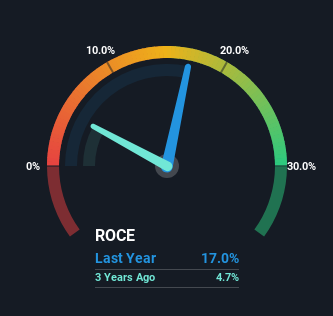HMS Bergbau (ETR:HMU) Is Experiencing Growth In Returns On Capital
What trends should we look for it we want to identify stocks that can multiply in value over the long term? Firstly, we'll want to see a proven return on capital employed (ROCE) that is increasing, and secondly, an expanding base of capital employed. If you see this, it typically means it's a company with a great business model and plenty of profitable reinvestment opportunities. With that in mind, we've noticed some promising trends at HMS Bergbau (ETR:HMU) so let's look a bit deeper.
Return On Capital Employed (ROCE): What Is It?
Just to clarify if you're unsure, ROCE is a metric for evaluating how much pre-tax income (in percentage terms) a company earns on the capital invested in its business. Analysts use this formula to calculate it for HMS Bergbau:
Return on Capital Employed = Earnings Before Interest and Tax (EBIT) ÷ (Total Assets - Current Liabilities)
0.17 = €15m ÷ (€227m - €140m) (Based on the trailing twelve months to June 2023).
Thus, HMS Bergbau has an ROCE of 17%. That's a relatively normal return on capital, and it's around the 16% generated by the Trade Distributors industry.
Check out our latest analysis for HMS Bergbau
Historical performance is a great place to start when researching a stock so above you can see the gauge for HMS Bergbau's ROCE against it's prior returns. If you'd like to look at how HMS Bergbau has performed in the past in other metrics, you can view this free graph of past earnings, revenue and cash flow.
The Trend Of ROCE
The trends we've noticed at HMS Bergbau are quite reassuring. The data shows that returns on capital have increased substantially over the last five years to 17%. The company is effectively making more money per dollar of capital used, and it's worth noting that the amount of capital has increased too, by 346%. This can indicate that there's plenty of opportunities to invest capital internally and at ever higher rates, a combination that's common among multi-baggers.
On a separate but related note, it's important to know that HMS Bergbau has a current liabilities to total assets ratio of 62%, which we'd consider pretty high. This effectively means that suppliers (or short-term creditors) are funding a large portion of the business, so just be aware that this can introduce some elements of risk. While it's not necessarily a bad thing, it can be beneficial if this ratio is lower.
The Bottom Line
In summary, it's great to see that HMS Bergbau can compound returns by consistently reinvesting capital at increasing rates of return, because these are some of the key ingredients of those highly sought after multi-baggers. Considering the stock has delivered 27% to its stockholders over the last five years, it may be fair to think that investors aren't fully aware of the promising trends yet. Given that, we'd look further into this stock in case it has more traits that could make it multiply in the long term.
One final note, you should learn about the 2 warning signs we've spotted with HMS Bergbau (including 1 which shouldn't be ignored) .
While HMS Bergbau may not currently earn the highest returns, we've compiled a list of companies that currently earn more than 25% return on equity. Check out this free list here.
Have feedback on this article? Concerned about the content? Get in touch with us directly. Alternatively, email editorial-team (at) simplywallst.com.
This article by Simply Wall St is general in nature. We provide commentary based on historical data and analyst forecasts only using an unbiased methodology and our articles are not intended to be financial advice. It does not constitute a recommendation to buy or sell any stock, and does not take account of your objectives, or your financial situation. We aim to bring you long-term focused analysis driven by fundamental data. Note that our analysis may not factor in the latest price-sensitive company announcements or qualitative material. Simply Wall St has no position in any stocks mentioned.

 Yahoo Finance
Yahoo Finance 
